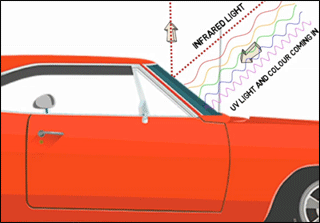For Science! A car gets so hot inside, we baked cookies!
Meteorologist/Science Writer
Monday, August 10, 2015, 6:05 PM - Leave your car locked up on a hot, sunny day and the inside can heat up like an oven. How much like an oven? Let's find out with a little baking For Science!
Sitting in a hot car for just 10 minutes can be unbearable for most people, as demonstrated by Weather Network reporter Leeanna MacLean in the video at the bottom of the article.
What, exactly, is going on here?
Glass is transparent due to the nature of light and because the molecules that make up the glass are fairly evenly spaced apart from one another.
Light waves that are tiny can slip right through the gaps between the molecules without much difficulty. This includes everything from gamma rays and x-rays, down through ultraviolet rays and visible light, and even into the near infrared. However, for longer wavelengths of light, the wave encounters more of the glass molecules, until eventually the waves are unable to pass through the glass and are reflected back from it. This longer wavelength coincides with the deeper regions of the infrared spectrum, which just happens to be the same range of wavelengths that radiate away from most objects as heat.
|
|
Thus, while the infrared waves are mostly blocked from entering the car from outside, those produced as the surfaces in the car - the dashboard, the seats, the steering wheel - try to get rid of excess energy by radiating it as heat, are blocked from leaving the car. This means that this infrared radiation bounces around in the car, being absorbed by more of the air molecules and more of the interior surfaces, and the temperature of everything inside the car rises.
The amount of heat that gets trapped inside the car is somewhat dependent on the outside temperature, since there is still some exchange of air between the inside and the outside. However, it only takes an outside temperature of around 21 degrees Celsius for the temperature inside of a car sitting in sunlight to reach 50 degrees C or higher.
Why is this so dangerous to people and animals that might be inside that hot car?
Humans, along with many other living creatures (including ones we keep as pets), stay alive because they are able to keep their internal body temperature within a certain range - warm enough that the proper chemical processes take place inside them, but still cool enough that the cells in our body do not become damaged. We mainly regulate our temperature simply by radiating heat from our skin, by breathing and by sweating.
However, as the temperature of the air around our body climbs, less heat can be transferred between the body and that air. Breathing warm air into your lungs means that air can only pick up a small part of the heat from inside your body. Sweat in hot, especially humid, air and that sweat will mostly stay on your skin instead of evaporating.
As soon as the body is producing heat faster than it can dump that heat to the outside air, hyperthermia sets in. The body's internal temperature rises, the same as if we had a fever from an infection, and we can suffer from heat stroke when body temperature reaches around 40 degrees Celsius.
For people, this is dangerous enough, especially for children and the elderly, who's ability to regulate temperature may not be as effective as an adult.
For pets, their ability to regulate their body temperature is much worse than for humans. Partly, this is because they usually have a layer of hair or fur all over their body, which helps them retain heat, but also limits their ability to sweat to only the pads of their paws. This really only leaves panting as their effective means of temperature regulation, which can be quickly overwhelmed when the temperature begins to rise in a hot car.
Exactly how hot can it get inside a car?
Read on for our account of two days of #HotCar experiments - where we demonstrated just how hot it can get, and the shocking use that heat can be put to.
IMPORTANT SAFETY NOTE: During this experiment, the cookies were exposed to temperatures in the car well above the recommended safe internal cooking temperature for egg products (74 degrees Celsius), for several hours. As the cookies were thin and light, they were heated thoroughly, killing any bacteria that may have been present in the raw egg contained in the ingredients.
While the internal consistency of the cookies shown in the video was less than ideal, they were shown when first removed from the car. After they were allowed to cool, they took on a more pleasing texture and were judged by Weather Network staff to be quite delicious.
Please be aware: If this experiment is attempted with any other type of food, the thickness, density and water content of that food should be taken into consideration. For anything thicker and heavier than these cookies, it is possible that some portions of the food may remain uncooked. Please follow the recommended safe internal cooking temperatures laid out by the Government of Canada food safety tips, and follow the "golden rule" for food safety: When in doubt, throw it out!
Source: Government of Canada
WATCH BELOW: Weather Network reporter Leeanna MacLean endures 10 grueling minutes to demonstrate how even that short amount of time is too long for anyone or anything to spend inside a hot, stuffy car.



